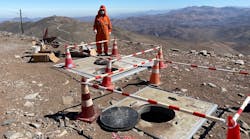Last week, engineers designing the Giant Magellan Telescope announced that they solved an immense design challenge. Specifically, protecting a 22-story rotating observatory and seven of the world’s largest monolithic mirrors from being damaged by earthquakes. The innovative seismic protection design earned top marks from an independent review panel of international experts in early November, paving the way for the next generation in observatory design.
“The structures of the next generation of extremely large telescopes are so massive, their instruments so sensitive, and the seismic environments they are located in are so intense, that there's really no way to avoid seismic protection. We need a seismic isolation system to keep the telescope operational,” said Dr. Bruce Bigelow, the Giant Magellan Telescope’s site, enclosure and facilities manager in a statement.
The Giant Magellan Telescope is a new 30-meter class ground-based telescope being constructed at Las Campanas Observatory in Chile’s Atacama Desert, one of the best locations on Earth to view the universe. But while this remote region boasts more than 300 clear nights of the galactic center per year, it also is home to some of the biggest, the most frequent, and the most destructive Earthquakes ever recorded. Large earthquakes in Chile can last for more than three minutes and often exceed seven on the surface-wave magnitude scale (MS).
Overcoming obstacles
Bigelow tells IndustryWeek, the biggest challenge in accomplishing this feat involved meeting the seismic protection requirements in a way that still enabled normal operation of the telescope. “Seismic isolation systems for regular buildings aim to protect the occupants, and most buildings are not typically dynamic structures in themselves. The telescope, in contrast, must be able to move in two angles (azimuth and elevation), and must be able to make those moves routinely, precisely, and continuously as the telescope tracks objects in the sky,” he says. “Consequently, the SIS must be rigid enough to resist the normal tracking reactions of the telescope (up to a certain threshold), and then smoothly transition to a flexible condition (above the threshold), to protect the telescope from strong ground motions.”
According to Bigelow, “the key to the GMT seismic isolation system is the use of a unique arrangement of commercially available seismic bearings (single friction pendulums), which have the necessary stiffness and friction properties to support normal operation of the telescope, and transition smoothly into an isolation function above a certain level of ground motion.”
A secondary, but also critical aspect of the design is the “pier re-centering and monitoring system” (PRMS), explains Bigelow. “The PRMS is a hydraulic system composed of hydraulic cylinders, sensors, and a control system, which provides the necessary forces to precisely re-position the telescope and pier (a combined mass of ~6200 metric tons, or ~14 million pounds) to the “home” position after a large earthquake,” he says.
Digging deeper
The seismic protection system — also known as a seismic isolation system — on the Giant Magellan Telescope is unprecedented in the world of telescopes, in terms of the size and complexity. Unlike hospitals or large bridges, the seismic isolation system needs to not only protect the structures from collapse, but also to prevent the structure and fragile optical components inside from requiring repair. Because the Giant Magellan Telescope’s seismic isolation system serves as the telescope foundation, it must be very reliable. By design, the probability of seismic isolation failure is less than 0.5 percent over the 50-year service life of the observatory. The system is designed to remain inactive during small “nuisance” earthquakes that are common at Las Campanas Observatory. The system will only engage during extreme earthquakes that will typically occur on a 1–2-year time scale.
The Giant Magellan Telescope’s seismic isolation system consists of two lines of defense that keep it safe and allow a return to operations within hours to weeks, depending on the magnitude of a seismic event.
1. Seismic Isolation System: A circular array of 24 single friction pendulum isolators that support the telescope and its pier and protect the telescope’s optical components and instruments from active ground motion caused by a major earthquake.
2. Pier Recentering System: A hydraulic system that can return the telescope to its original resting and operational position following a major earthquake.
After a major earthquake, the friction pendulum isolators may not return the telescope exactly back to its normal operation position. “The isolation system will return the telescope to its ‘home’ position within a couple of inches, but that’s not good enough,” said Bigelow in a statement. “That’s where the hydraulics of the pier recentering system come in, which can move the 6,000 metric tons of telescope and pier and return the telescope to a fraction of an inch from where it was before the earthquake.”




